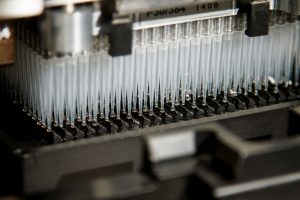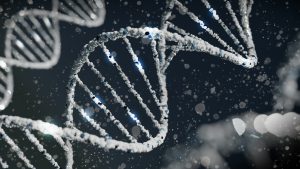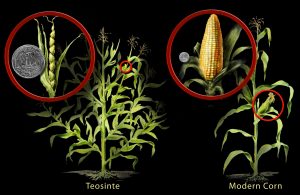When a child is first born, their pediatric care includes the use of region-specific sequencing analysis to look over their individual genome. This type of analysis is used to understand disease as it offers the ability to know what a patient may have. However, as technology and medicine continue to develop, ethical concerns arise as to whether this much information on a single individual should be available to healthcare providers. Although the data that can be obtained from pediatric genome analyzation is often used to the patient’s benefit, it does not eliminate the possibility of unsolicited feelings when the testing goes beyond what the original purpose was. As of the time being there is a need for updated policy guidelines to address this moral conundrum in order to keep patients, parents, and healthcare workers protected. By having upfront communication with the patient and their family as to what the information collected can do for the patient, this form of DNA data analysis can be obtained ethically with a full understanding of its purpose.

Genome sequencing is often used for identification of diseases such as cancers, mental disorders, and other similar diagnosis. This process may start from as young as infancy as there is an opportunity to screen for any of the aforementioned indications. As of 2024, upon proper justification “…newborn screening programs are set up to collect a specimen and send it to the newborn screening laboratory within 48 h of birth, with results returned to the pediatrician, and often a specialist, shortly thereafter,” with parental consent for this screening often not being necessary for it to occur 1. While this usually occurs with infants in high-risk conditions that are in need of urgent screening conditions as a means of attempting to provide the best care for the newborn, many people argue that a child getting screened should be overseen by a parent or guardian, or at the very least allowed some form of consent to be obtained prior to it. This scenario displays the importance of ensuring that whatever data is found to be used to “grant the maximum benefit for the care of the children, while preventing patient harm and disproportionate overload of clinicians and the healthcare system” 2. With the current climate of the American Healthcare System, additional unnecessary screenings only further contribute to the problem by endangering the relationship between healthcare practitioners and their patients.

Despite this, genome sequencing has proven to be incredibly powerful in assisting the observation of a person’s genetics regarding diseases, disabilities, and other similar issues. The hope is that by catching these sequences quickly and early on, any treatments on the child will be efficient and cost-effective. Upon these findings, patients and their parents are led to government programs that are put in place to help the child if the family is unable to contribute financially. These factors can, in theory, be found through the aforementioned newborn screening that would be of no issue to either the parent or child if it served to have a positive impact. The rise of methods such as artificial intelligence (AI) have also proven to be helpful through the use of previously collected data to identify and predict what it needs to. With each passing day, there are more incentives to keep furthering this research as it allows for mortality rates to dwindle with its increasing accuracy and preciseness. By using previous patient records in addition to new ones, this “could enable AI to assist in significant medical activities such as diagnosing, prognosing, and making treatment recommendations” without the use of human intervention, creating a cheaper and less time-intensive solution 3.
Due to the reach of how far genome-wide sequencing can reach when analyzed fully, improper usage of it can lead to several challenges for clinicians as well as researchers. If the person handling the genetic information is improperly trained, it would lead to incorrect decisions, and possibly “the risk of injustice due to unequal access to reimbursement by insurances” if the findings lean towards a more serious diagnosis 4. It is very important that whatever information is obtained is precise and accurate in order to not run the risk of inconsistencies. The chances that the data results from the sequences get used to further the medical community’s knowledge is very likely, especially if the sequence leads to finding a particularly pressing disease that requires detection as early as possible. AI tools are often fed this data. If mistakes manage to slip through the cracks enough times it may no longer be a viable tool which would be a huge setback to whatever information it had stored within it.

While the information that can be obtained through these sequencing methods can be crucial, it should also be obtained ethically. The usage of past patient data to be used as a training model can be a cause for concern if the patient is not at an age where they can provide consent, or the parent or guardian is not made aware that the child’s information is being used in that matter. There is a need for respect of personal autonomy, accountability, and especially privacy. If a patient is only going to the clinician for a specific issue, only that issue and anything else that may relate to it should be what is looked over rather than miscellaneous data unrelated to what is being discussed. Additionally, the genome sequence may not be completely accurate if done improperly, which would then lead to more problems than solutions. By instead allowing a choice as to how the data is used, and what data is collected in general, patients and any associated parties are likely to feel more comfortable going to healthcare professionals whenever they need to.
Some argue that information obtained through these tests can prove to be lifesaving even if it was unintentional. An example is how “some families have literally gone to the doctor concerned about a flu only to find out that their child has cancer on the same day,” which is a diagnosis that is best obtained early on 5. It cannot be denied that this interaction would be deemed a positive one, as it would mean that there are steps to help the prevention of a worsening condition. However, “informed consent is a foundation of the ethical practice of medicine and a cornerstone of efforts to protect human subjects from research risk,” and going beyond the parameters of what a person is to do should not be the standardized practice 6. If there are incidental findings found, there should be a discussion between the practitioner and the parents or guardians. By being upfront about what was found, the results can then be analyzed with the parent or guardian, allowing them to make an informed decision on the future of the child in question. Scenarios where multiple lives can benefit from a screening should be taken into consideration when discussing the ethics of genome sequencing.
Cases such as the one above also lead to the question of how this data is being analyzed. More specifically, when it is being fed into databases to be used by other clinicians as well as to train AI models, what level of consent is offered to those involved? Based on studies done over the years, there have been efforts to not only get the parent or guardian of the child involved, but the child as well whilst taking into account said child’s age and maturity. This way there is a connection being made that allows everyone to have a say in the situation, allowing the data to be applicable and informative. There have been efforts to create an environment in which well-informed decision-making” as a means to assist in this process, with “the guidelines [being] the subject of continual evaluation” 7. Additionally, the rise of technological advances will make it so that any guidelines created are “updated as new developments and academic insights emerge”, creating for a more open environment where the necessary information is provided 8.

It is still crucial that healthcare professionals understand the gravity of the situation prior to making their decision on how they want to go about relaying the information to their patients. It is imperative that they “weigh the potential medical benefits of genomic testing against its current limitations,” of which includes “variability in the expression and penetrance of a disease, potential risks of unnecessary testing, negative psychological effects, and incidental findings with uncertain predictive value” as all of these factors will contribute to how any encounters with the patient will be going forward 9. Additionally, the data that is found needs to be treated with respect as “while medical personnel may feel that AI is just ‘another computer system,’ parents may feel differently,” primarily due to the fear of the unknown of how the system works, or the negative stigma that may surround non-healthcare related AI 10. During this consultation period the healthcare provider should try their best to explain what is needed to their patients in a way that keeps them informed while also not overwhelming those that are being spoken to.
A factor to take into consideration is the age of the child, as it can play a key role in what can be elaborated upon, what language can be used, and what decisions can be made by them. In the case of a child who is still heavily reliant on their parent or guardian, adequate informed consent needs to be spoken about with the caretaker of the child rather than just the child themselves. The healthcare provider needs to ensure that the “informed consent should include a review and discussion about results of testing, intended and unintended (ie, incidental findings), and agreement should be reached on whether and how results will be disclosed” 11. Test results obtained from these discussions can then be used to further clinical advancements and knowledge, but also allowed autonomy for the family in question. If the analysis reveals that the child is at high risk of some form of disease and that there is a possibility that it runs in the family, steps can be made to keep the child as well as the family safe and informed.

Although it is often in a healthcare practitioner’s best interest to only do what is required of them and their job, it is also necessary to be understanding and compassionate towards those they are assisting. Oftentimes a person in a healthcare role may not think twice about what they are informing an individual of and what the results of their genome sequence may entail. This also applies to the newborn screening, as while it may prove to be a “tremendously successful public health program,” there should be at least some type of consultation between the parents and the place of operation doing the screening 12. As time has gone by, efforts to provide adequate summaries to patients and their families have risen. “Overall, the majority of participating healthcare professionals support approaching families within the first 4 weeks from diagnosis,” as intervening early allows for the creation of a plan of how to approach the issue at hand, which can then assist in the prevention of further problems later on 13.
Ethics and medicine are often at odds with one another, whether it is due to the possibility of using data to significantly allow the progression of a topic or the creation of new solutions to previously unsolved problems. Oftentimes the information that is found via sequencing can lead to improper usage due to a lack of proper communication. In the end, there is a need to obtain consent from the individuals whose genome sequencing is being used, and parental consent should be required in order to keep said child safe. As technology and healthcare continue to progress with time, there is a need for more guidelines to protect the privacy of individuals whilst providing them with the individualized care they require. Upon a healthcare practitioner’s upfront communication with all involved with regard to the data in question, genome sequencing can continue to be as important as it often finds itself to be.
- Currier, Robert J. “Newborn Screening Is on a Collision Course with Public Health Ethics.” MDPI, September 26, 2022. https://www.mdpi.com/2409-515X/8/4/51. ↵
- Eichinger, Johanna, Bernice S. Elger, Insa Koneacute;, Isabel Filges, David Shaw, Bettina Zimmermann, and Stuart McLennan. “The Full Spectrum of Ethical Issues in Pediatric Genome-Wide Sequencing: A Systematic Qualitative Review – BMC Pediatrics.” SpringerLink, September 6, 2021. https://link.springer.com/article/10.1186/s12887-021-02830-w#citeas. ↵
- Coghlan, Simon, Christopher Gyngell, and Danya F Vears. “Ethics of Artificial Intelligence in Prenatal and Pediatric Genomic Medicine – Journal of Community Genetics.” SpringerLink, October 5, 2023. https://link.springer.com/article/10.1007/s12687-023-00678-4#citeas. ↵
- Eichinger, Johanna, Bernice S. Elger, Insa Koneacute;, Isabel Filges, David Shaw, Bettina Zimmermann, and Stuart McLennan. “The Full Spectrum of Ethical Issues in Pediatric Genome-Wide Sequencing: A Systematic Qualitative Review – BMC Pediatrics.” SpringerLink, September 6, 2021. https://link.springer.com/article/10.1186/s12887-021-02830-w#citeas. ↵
- Byrjalsen, Anna, Ayo Wahlberg, Anders Castor, Ulrik K. Stoltze, and. “Germline Whole Genome Sequencing in Pediatric Oncology in Denmark—Practitioner Perspectives.” Wiley Online Library, June 4, 2020. https://onlinelibrary.wiley.com/doi/full/10.1002/mgg3.401. ↵
- Kodish, Eric, and Seth J. Rotz. “Ethical Conundrums in Pediatric Genomics | Hematology, Ash Education Program | American Society of Hematology.” Ash Publications, November 30, 2018. https://ashpublications.org/hematology/article/2018/1/301/277595/Ethical-conundrums-in-pediatric-genomics. ↵
- Bolt, Ineke, Cadice Cornelis, Wybo Dondorp, Guido de Wert, Marieke van Summeren, Eva Brilstra, Nine Knoers, and Annelien L. Bredenoord. “Uncertain Futures and Unsolicited Findings in Pediatric Genomic Sequencing: Guidelines for Return of Results in Cases of Developmental Delay – BMC Medical Ethics.” BioMed Central, November 11, 2023. https://bmcmedethics.biomedcentral.com/articles/10.1186/s12910-023-00977-y. ↵
- Bolt, Ineke, Cadice Cornelis, Wybo Dondorp, Guido de Wert, Marieke van Summeren, Eva Brilstra, Nine Knoers, and Annelien L. Bredenoord. “Uncertain Futures and Unsolicited Findings in Pediatric Genomic Sequencing: Guidelines for Return of Results in Cases of Developmental Delay – BMC Medical Ethics.” BioMed Central, November 11, 2023. https://bmcmedethics.biomedcentral.com/articles/10.1186/s12910-023-00977-y. ↵
- de Montgolfier, Sandrine, Khadija Lahlou-Laforêt, Lucile Hervouet, and Marion Droin-Mollard. “Narrative Review on Ethical and Psychological Issues Raised by Genetic and Genomic Testing in Pediatric Oncology Care.” Wiley Online Library, July 29, 2024. https://onlinelibrary.wiley.com/doi/abs/10.1002/jgc4.1644. ↵
- Coghlan, Simon, Christopher Gyngell, and Danya F Vears. “Ethics of Artificial Intelligence in Prenatal and Pediatric Genomic Medicine – Journal of Community Genetics.” SpringerLink, October 5, 2023. https://link.springer.com/article/10.1007/s12687-023-00678-4#citeas. ↵
- Kodish, Eric, and Seth J. Rotz. “Ethical Conundrums in Pediatric Genomics | Hematology, Ash Education Program | American Society of Hematology.” Ash Publications, November 30, 2018. https://ashpublications.org/hematology/article/2018/1/301/277595/Ethical-conundrums-in-pediatric-genomics. ↵
- Currier, Robert J. “Newborn Screening Is on a Collision Course with Public Health Ethics.” MDPI, September 26, 2022. https://www.mdpi.com/2409-515X/8/4/51. ↵
- Bolt, Ineke, Cadice Cornelis, Wybo Dondorp, Guido de Wert, Marieke van Summeren, Eva Brilstra, Nine Knoers, and Annelien L. Bredenoord. “Uncertain Futures and Unsolicited Findings in Pediatric Genomic Sequencing: Guidelines for Return of Results in Cases of Developmental Delay – BMC Medical Ethics.” BioMed Central, November 11, 2023. https://bmcmedethics.biomedcentral.com/articles/10.1186/s12910-023-00977-y. ↵



4 comments
arosales11
This essay delves deeply into the ethical issues raised by genomic sequencing in pediatric treatment. I was particularly impressed by the balanced approach, which takes into account both the possible medical advantages and the ethical problems associated with such detailed genetic testing. The essay successfully emphasizes the necessity of informed consent, patient privacy, and open communication between healthcare practitioners and families.
Natalia De la garza
This is a great infographic! It explains pediatric genome sequencing so clearly and shows how amazing it is for helping detect diseases early. It also talks about the importance of being open with families, which makes it even better. It’s such a great way to learn about this exciting technology so informative and well done!
Alysia Cano
This piece raises important ethical considerations regarding the use of genomic sequencing in pediatric care, especially in terms of consent, privacy, and the potential for incidental findings. Clear communication, informed consent, and ongoing policy updates are essential to ensuring that genome sequencing remains beneficial while respecting patients’ and families’ autonomy and privacy.
Danielle Villanueva
This article provides a comprehensive and nuanced exploration of the ethical challenges surrounding genome sequencing in pediatric care. I was particularly impressed by the balanced approach that considers both the potential medical benefits and the ethical concerns of such comprehensive genetic testing. The piece effectively highlights the importance of informed consent, patient privacy, and the need for clear communication between healthcare providers and families. I’m curious about how rapidly these ethical guidelines are evolving to keep pace with technological advancements in genetic testing and AI.